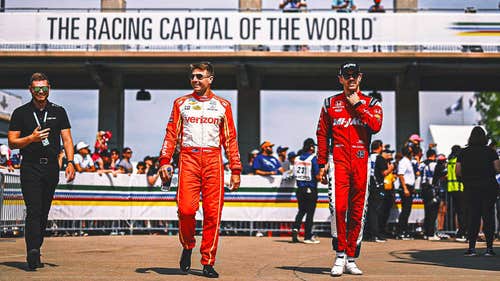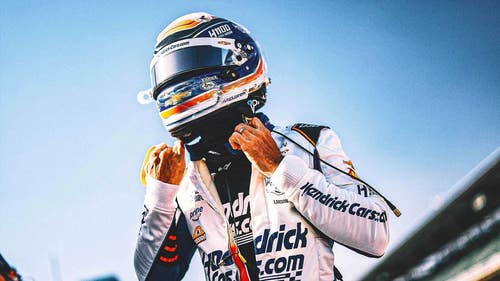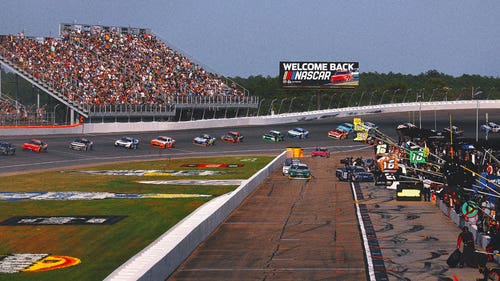
After Joey Logano's scary crash, NASCAR needs to reassess the safety of its cars
By Bob Pockrass
FOX Sports NASCAR Writer
TALLADEGA, Ala. – The frustration Joey Logano vented after his nasty flip Sunday at Talladega Superspeedway was warranted.
Drivers should be frustrated after getting airborne. They should wonder if NASCAR needs to change the aerodynamic package – again – to try to find the balance (if that’s even possible) between exciting racing and acceptable risk at Daytona and Talladega.
"I am mad about being in the crash, and on the other [hand], I am happy to be alive," said Logano, who was also involved in a hard crash at the Daytona 500. "On another hand, I am wondering when we are going to stop because this is dangerous doing what we are doing."
NASCAR has been adjusting the package at these tracks for more than 30 years because the banking at these ovals is so high that NASCAR must restrict the airflow in the engines to keep them from going 220 mph or faster.
That results in an aerodynamic draft that rarely forces drivers to lift off the throttle, bunching them together in tight packs and therefore increasing the chance for contact and thus increasing the likelihood of more cars piling into the carnage.
NASCAR made changes to the cars after the scary Ryan Newman accident in the 2020 Daytona 500, after which he was rushed to the hospital with a head injury. He walked out of the hospital a couple of days later and was back testing a car the next month.
Looking for more NASCAR content? Sign up for the FOX Sports NASCAR Newsletter with Bob Pockrass!
Among the changes:
- The holes in the tapered spacer were decreased from 59/64ths of an inch in diameter to 57/64ths of an inch, decreasing horsepower from 550 to 500-510 for Daytona and Talladega.
- A lower main roll bar support, intrusion plate and upper main roll bar support bar were added (mandatory at Daytona and Talladega; optional elsewhere). This change was designed to keep a car from crushing on top of the driver.
- Aero ducts were eliminated at superspeedway tracks. This was to keep the cars from tandem drafting as much and to decrease the speed of the runs drivers got on one another. It also was to make it more difficult to block.
But the drivers are still getting big runs. And Logano noted that his roof nearly caved in on him.
"I got a roll bar in my head," Logano said. "That is not OK. I am one hit away from the same situation Ryan Newman just went through. I just don't feel like that is acceptable. ... A lot of it is the big spoiler and the big runs and all the pushing."
The safest packages would result in drivers racing in a single-file line – which has happened in the past at Talladega for much of the race. The most dangerous have the closing rates giving drivers virtually no time to react, whether they are trying to block a move from behind or trying to slow down to avoid hitting the car in front of them.
Newman, Austin Dillon and Kyle Larson have all been involved in devastating crashes at these tracks over the past decade.
"The run is so big," said Logano teammate Ryan Blaney. "They’re coming way faster behind the leader, and it just all stacks up – even three years ago, there was a different kind of [Talladega] racing.
"The runs weren’t as big with that package, but I thought it was still pretty decent, so I don’t know. ... The runs are massive, and they’re really hard to stay stable, especially when you’ve got somebody on your bumper."
In Logano’s wreck Sunday, his car was high enough that it hit the windshield of Bubba Wallace.
"We got really fortunate today that Bubba was able to kind of avoid a major contact," Penske technical director Travis Geisler said.
Geisler said he believes it's the fast closing rate that is resulting in the accidents, and the spoiler is also a challenge.
"No question, it's probably one of the more difficult [packages] for us to deal with from managing the lanes, managing the runs and trying to decide what's a safe block and what's not," Geisler said.
"You see some thrown throughout the day. Man, it's a lot of skill that gets us through it."
But even with all that driver skill, they can’t do a thing once their wheels come off the ground.
"We're pretty good drivers, but none of that stuff works when we're in the air," Talladega winner Brad Keselowski said. "The gas pedal, brake pedal, steering wheel, shifter. We're not rudders. When that thing gets in the air, it lands where it wants to.
"What goes up must come down. It's not a jet-propelled airplane. We have no way to control where it comes down, so we absolutely have to find a way to keep them from coming off the ground."
Keselowski was the master of blocking and holding the lead with previous packages, something that seemed easier to do about four years ago. He also was involved in one of the sport’s wildest finishes at Talladega, which resulted in Carl Edwards getting airborne and Keselowski earning his first Cup win in 2009.
"This particular rules package, it's so easy to build a run, incredibly easy to build a run," Keselowski said. "I don't know if you have to have quite as much tact.
"But it does make for more side-by-side racing. I think the fans like that. There's some tradeoffs."
For more up-to-date news on all things NASCAR, click here to register for alerts on the FOX Sports app!
William Byron, who finished second to Keselowski, said he likes this package because it allows a driver to get side-by-side more easily than they could a few years ago.
"I wasn't a huge fan when I came into Cup," he said. "We had the huge bubble effect. Guys could just control the lanes, basically could control the race for the whole time. I feel like that was boring.
"I feel like now we have the ability to push through that bubble, obviously. It's all about your push, having a car that can manage the push."
Byron, though, said NASCAR could slow the cars down a few miles per hour more and they would be fine. Slowing cars down could help keep cars on the ground with less violent impacts, but it could also bunch up the field even more.
The quandary for NASCAR is that it has just two races left with the current car at Daytona and Talladega before it goes to a completely new car in 2022. The "Next Gen" car has a much more sealed-off underbody, which some fear could make it more prone to liftoff.
Geisler said there are, however, some components on the car to create a little more downforce in a spin to potentially prevent the vehicle from going airborne.
NASCAR will have to dictate the size of the rear spoiler, which could be key. The spoiler for Daytona and Talladega is 9 inches tall – 1 inch taller than at tracks of similar size but without as much banking and 6.25 inches taller than what NASCAR uses on road courses and short tracks.
"Certainly, no question, the size of the rear spoiler is challenging to overcome," Geisler said. "When you get backward with that much kind of in the air, it's a lot to deal with.
"That's something we'll try to learn. There's only two more left, but one more race left is too many if you're not 100 percent sure you're as safe as you can be."
There is no doubt that NASCAR will have to focus on how this car will race for the 2022 Daytona 500.
Logano might not know what to fix, but he knows what he wants to see.
"We have to fix it," he said. "Someone already got hurt, and we are still doing it, so that’s not real smart. At the same time, I am appreciative of driving a car that is this safe."
Thinking Out Loud
NASCAR didn’t have any drama with the double-yellow-line rule at Talladega. Its only call was a no-call when Matt DiBenedetto had contact with Kyle Busch and pushed him below the yellow line. That was considered a racing incident.
Does that mean NASCAR’s heavy hand on the issue at Talladega in October sent its message, and drivers have adapted?
Maybe.
The real test is still to come with the upcoming races at Daytona and Talladega, where there theoretically is more on the line, with Daytona the regular-season finale and Talladega a playoff race.
Stat of Note
Brad Keselowski has won a race in 11 consecutive seasons.
Social Spotlight
They Said It
"We'll ask the drivers frankly to try to promote the vaccination process. I think it's really important. They have a voice. That voice carries a lot of weight. To the degree that we can help with folks who are uncertain about whether they want to get the vaccine, I think it would be critical to have those with the loudest voice within the sport talking about their vaccinations." – NASCAR President Steve Phelps
Bob Pockrass has spent decades covering motorsports, including the past 30 Daytona 500s. He joined FOX Sports in 2019 following stints at ESPN, Sporting News, NASCAR Scene magazine and The (Daytona Beach) News-Journal. Follow him on Twitter and Instagram @bobpockrass. Looking for more NASCAR content? Sign up for the FOX Sports NASCAR Newsletter with Bob Pockrass!








